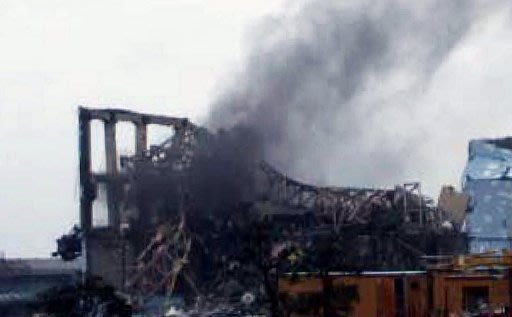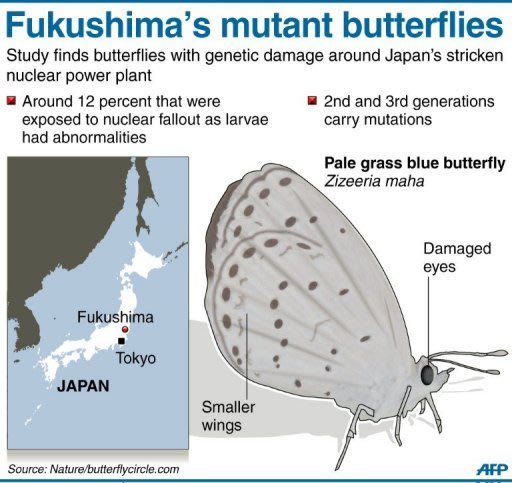
Smoke billows from TEPCO's crippled Fukushima Daiichi nuclear power plant in March 2011. Genetic mutations have been found in three generations of butterflies from near Japan's crippled Fukushima nuclear plant, raising fears radiation could affect other species
Genetic mutations have been found in three generations of butterflies from near Japan's crippled Fukushima nuclear plant, scientists said Tuesday, raising fears radiation could affect other species.

Around 12 percent of pale grass blue butterflies that were exposed to nuclear fallout as larvae immediately after the tsunami-sparked disaster had abnormalities, including smaller wings and damaged eyes, researchers said.
The insects were mated in a laboratory well outside the fallout zone and 18 percent of their offspring displayed similar problems, said Joji Otaki, associate professor at Ryukyu University in Okinawa, southwestern Japan.
That figure rose to 34 percent in the third generation of butterflies, he said, even though one parent from each coupling was from an unaffected population.
The researchers also collected another 240 butterflies in Fukushima in September last year, six months after the disaster. Abnormalities were recorded in 52 percent of their offspring, which was "a dominantly high ratio", Otaki told AFP.
Otaki said the high ratio could result from both external and internal exposure to radiation, from the atmosphere and in contaminated foodstuffs.
The results of the study were published in Scientific Reports, an online research journal from the publishers of Nature.
Otaki later carried out a comparison test in Okinawa exposing unaffected butterflies to low levels of radiation, with the results showing similar rates of abnormality, he said.
"We have reached the firm conclusion that radiation released from the Fukushima Daiichi plant damaged the genes of the butterflies," Otaki said.
The quake-sparked tsunami of March 2011 knocked out cooling systems at the Fukushima Daiichi nuclear power plant, causing three reactors to go into meltdown in the world's worst atomic disaster for 25 years.
The findings will raise fears over the long-term effects of the leaks on people who were exposed in the days and weeks after the accident, as radiation spread over a large area and forced thousands to evacuate.
There are claims that the effects of nuclear exposure have been observed on successive generations of descendants of people living in Hiroshima and Nagasaki when the US dropped atomic bombs in the final days of World War II.
But Otaki warned it was too soon to jump to conclusions, saying his team's results on the Fukushima butterflies could not be directly applied to other species, including humans.
He added he and his colleagues would conduct follow-up studies including similar tests on other animals.
Kunikazu Noguchi, associate professor in radiological protection at Nihon University School of Dentistry, also said more data was needed to determine the impact of the Fukushima accident on animals in general.
"This is just one study," Noguchi said. "We need more studies to verify the entire picture of the impact on animals."
Researchers and medical doctors have so far denied that the accident at Fukushima would cause an elevated incidence of cancer or leukaemia, diseases that are often associated with radiation exposure.
But they also noted that long-term medical examination is needed especially due to concerns over thyroid cancer among young people -- a particular problem for people following the Chernobyl catastrophe.
"There are a number of unknown factors surrounding the genetic impact of radiation," said Makoto Yamada, a medical doctor who examines Fukushima residents. "We still cannot 100 percent deny that the impact may come out in the future."
Associate professor Noguchi said: "The case of Fukushima plant workers is a different story. Some of them have already topped exposure limits. It is necessary to strictly monitor them to see if there is any impact."
No one is officially recorded as having died as a direct result of the Fukushima disaster, but many who fled the area and those who remain, including workers decommissioning the crippled plant, worry about the long-term effects.
Scientists have warned it could be decades before it is safe for some people to return to their homes.
"Even if there is no impact now, we have to live with fear," said Sachiko Sato, a mother of two, who temporarily fled from Fukushima. "And concerns will be handed down to my children and grandchildren."


